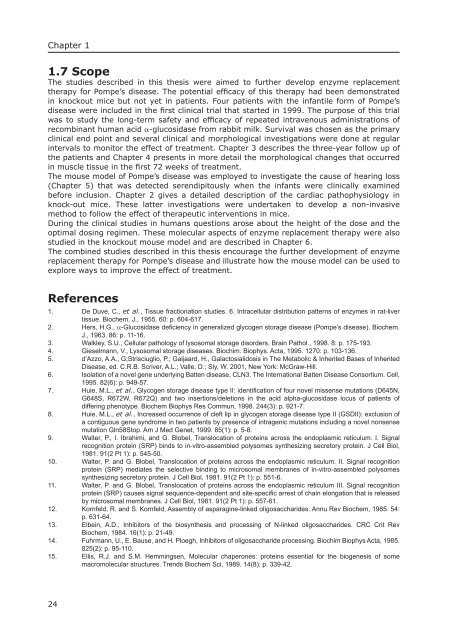Pompe's disease - RePub - Erasmus Universiteit Rotterdam
Pompe's disease - RePub - Erasmus Universiteit Rotterdam
Pompe's disease - RePub - Erasmus Universiteit Rotterdam
Create successful ePaper yourself
Turn your PDF publications into a flip-book with our unique Google optimized e-Paper software.
Chapter 1<br />
1.7 Scope<br />
The studies described in this thesis were aimed to further develop enzyme replacement<br />
therapy for Pompe’s <strong>disease</strong>. The potential effi cacy of this therapy had been demonstrated<br />
in knockout mice but not yet in patients. Four patients with the infantile form of Pompe’s<br />
<strong>disease</strong> were included in the fi rst clinical trial that started in 1999. The purpose of this trial<br />
was to study the long-term safety and effi cacy of repeated intravenous administrations of<br />
recombinant human acid α-glucosidase from rabbit milk. Survival was chosen as the primary<br />
clinical end point and several clinical and morphological investigations were done at regular<br />
intervals to monitor the effect of treatment. Chapter 3 describes the three-year follow up of<br />
the patients and Chapter 4 presents in more detail the morphological changes that occurred<br />
in muscle tissue in the fi rst 72 weeks of treatment.<br />
The mouse model of Pompe’s <strong>disease</strong> was employed to investigate the cause of hearing loss<br />
(Chapter 5) that was detected serendipitously when the infants were clinically examined<br />
before inclusion. Chapter 2 gives a detailed description of the cardiac pathophysiology in<br />
knock-out mice. These latter investigations were undertaken to develop a non-invasive<br />
method to follow the effect of therapeutic interventions in mice.<br />
During the clinical studies in humans questions arose about the height of the dose and the<br />
optimal dosing regimen. These molecular aspects of enzyme replacement therapy were also<br />
studied in the knockout mouse model and are described in Chapter 6.<br />
The combined studies described in this thesis encourage the further development of enzyme<br />
replacement therapy for Pompe’s <strong>disease</strong> and illustrate how the mouse model can be used to<br />
explore ways to improve the effect of treatment.<br />
References<br />
1. De Duve, C., et al., Tissue fractionation studies. 6. Intracellular distribution patterns of enzymes in rat-liver<br />
tissue. Biochem. J., 1955. 60: p. 604-617.<br />
2. Hers, H.G., α-Glucosidase defi ciency in generalized glycogen storage <strong>disease</strong> (Pompe’s <strong>disease</strong>). Biochem.<br />
J., 1963. 86: p. 11-16.<br />
3. Walkley, S.U., Cellular pathology of lysosomal storage disorders. Brain Pathol., 1998. 8: p. 175-193.<br />
4. Gieselmann, V., Lysosomal storage <strong>disease</strong>s. Biochim. Biophys. Acta, 1995. 1270: p. 103-136.<br />
5. d’Azzo, A.A., G;Strisciuglio, P.; Galjaard, H., Galactosialidosis in The Metabolic & Inherited Bases of Inherited<br />
Disease, ed. C.R.B. Scriver, A.L.; Valle, D.; Sly, W. 2001, New York: McGraw-Hill.<br />
6. Isolation of a novel gene underlying Batten <strong>disease</strong>, CLN3. The International Batten Disease Consortium. Cell,<br />
1995. 82(6): p. 949-57.<br />
7. Huie, M.L., et al., Glycogen storage <strong>disease</strong> type II: identifi cation of four novel missense mutations (D645N,<br />
G648S, R672W, R672Q) and two insertions/deletions in the acid alpha-glucosidase locus of patients of<br />
differing phenotype. Biochem Biophys Res Commun, 1998. 244(3): p. 921-7.<br />
8. Huie, M.L., et al., Increased occurrence of cleft lip in glycogen storage <strong>disease</strong> type II (GSDII): exclusion of<br />
a contiguous gene syndrome in two patients by presence of intragenic mutations including a novel nonsense<br />
mutation Gln58Stop. Am J Med Genet, 1999. 85(1): p. 5-8.<br />
9. Walter, P., I. Ibrahimi, and G. Blobel, Translocation of proteins across the endoplasmic reticulum. I. Signal<br />
recognition protein (SRP) binds to in-vitro-assembled polysomes synthesizing secretory protein. J Cell Biol,<br />
1981. 91(2 Pt 1): p. 545-50.<br />
10. Walter, P. and G. Blobel, Translocation of proteins across the endoplasmic reticulum. II. Signal recognition<br />
protein (SRP) mediates the selective binding to microsomal membranes of in-vitro-assembled polysomes<br />
synthesizing secretory protein. J Cell Biol, 1981. 91(2 Pt 1): p. 551-6.<br />
11. Walter, P. and G. Blobel, Translocation of proteins across the endoplasmic reticulum III. Signal recognition<br />
protein (SRP) causes signal sequence-dependent and site-specifi c arrest of chain elongation that is released<br />
by microsomal membranes. J Cell Biol, 1981. 91(2 Pt 1): p. 557-61.<br />
12. Kornfeld, R. and S. Kornfeld, Assembly of asparagine-linked oligosaccharides. Annu Rev Biochem, 1985. 54:<br />
p. 631-64.<br />
13. Elbein, A.D., Inhibitors of the biosynthesis and processing of N-linked oligosaccharides. CRC Crit Rev<br />
Biochem, 1984. 16(1): p. 21-49.<br />
14. Fuhrmann, U., E. Bause, and H. Ploegh, Inhibitors of oligosaccharide processing. Biochim Biophys Acta, 1985.<br />
825(2): p. 95-110.<br />
15. Ellis, R.J. and S.M. Hemmingsen, Molecular chaperones: proteins essential for the biogenesis of some<br />
macromolecular structures. Trends Biochem Sci, 1989. 14(8): p. 339-42.<br />
24

















